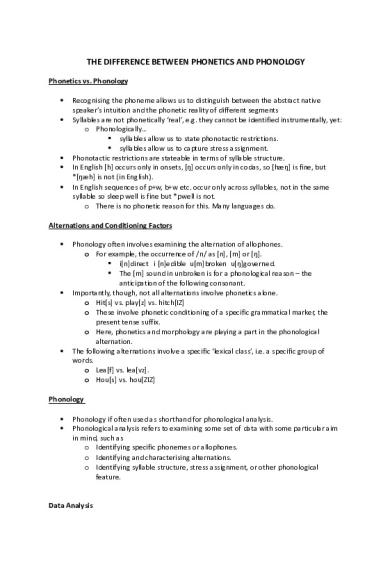THE Difference Between Phonetics AND Phonology PDF

| Title | THE Difference Between Phonetics AND Phonology |
|---|---|
| Author | Greg Lawson |
| Course | Phonetics and Phonology |
| Institution | Newcastle University |
| Pages | 2 |
| File Size | 84.1 KB |
| File Type | |
| Total Downloads | 51 |
| Total Views | 224 |
Summary
The Difference Between Phonetics and Phonology....
Description
THE DIFFERENCE BETWEEN PHONETICS AND PHONOLOGY Phonetics vs. Phonology
Recognising the phoneme allows us to distinguish between the abstract native speaker’s intuition and the phonetic reality of different segments Syllables are not phonetically ‘real’, e.g. they cannot be identified instrumentally, yet: o Phonologically… syllables allow us to state phonotactic restrictions. syllables allow us to capture stress assignment. Phonotactic restrictions are stateable in terms of syllable structure. In English [h] occurs only in onsets, [ŋ] occurs only in codas, so [hæŋ] is fine, but *[ŋæh] is not (in English). In English sequences of p+w, b+w etc. occur only across syllables, not in the same syllable so sleep well is fine but *pwell is not. o There is no phonetic reason for this. Many languages do.
Alternations and Conditioning Factors
Phonology often involves examining the alternation of allophones. o For example, the occurrence of /n/ as [n], [m] or [ŋ]. i[n]direct i [n]edible u[m]broken u[ŋ]governed. The [m] sound in unbroken is for a phonological reason – the anticipation of the following consonant. Importantly, though, not all alternations involve phonetics alone. o Hit[s] vs. play[z] vs. hitch[IZ] o These involve phonetic conditioning of a specific grammatical marker, the present tense suffix. o Here, phonetics and morphology are playing a part in the phonological alternation. The following alternations involve a specific ‘lexical class’, i.e. a specific group of words. o Lea[f] vs. lea[vz]. o Hou[s] vs. hou[ZIZ]
Phonology
Phonology if often used as shorthand for phonological analysis. Phonological analysis refers to examining some set of data with some particular aim in mind, such as o Identifying specific phonemes or allophones. o Identifying and characterising alternations. o Identifying syllable structure, stress assignment, or other phonological feature.
Data Analysis
Following are two data analysis problems… Both involve the examination of data to determine the status of specific segments as either separate phonemes or allophones (of a single phoneme). Tojolabal (Mexico): In Tojolabal, [k] and [k’] must be separate phonemes. o They appear in identical phonetic environments. o They form near-minimal pairs. German: [x] – voiceless velar fricative, as in buch [bux] ‘book’ and bach [bax] ‘beck, stream’. [ç] – voiceless palatal fricative, as in ich [iç] ‘I’ and Dolch [d ɔlç] ‘dagger’. We can say that German [x] occurs following back vowels, and German [ç] occurs elsewhere. In German, [x] and [ç] are allophones of a single phoneme....
Similar Free PDFs

Phonetics & Phonology
- 4 Pages

English Phonetics and Phonology
- 13 Pages

Phonetics and phonology
- 46 Pages

lecture - Phonology or Phonetics
- 5 Pages
Popular Institutions
- Tinajero National High School - Annex
- Politeknik Caltex Riau
- Yokohama City University
- SGT University
- University of Al-Qadisiyah
- Divine Word College of Vigan
- Techniek College Rotterdam
- Universidade de Santiago
- Universiti Teknologi MARA Cawangan Johor Kampus Pasir Gudang
- Poltekkes Kemenkes Yogyakarta
- Baguio City National High School
- Colegio san marcos
- preparatoria uno
- Centro de Bachillerato Tecnológico Industrial y de Servicios No. 107
- Dalian Maritime University
- Quang Trung Secondary School
- Colegio Tecnológico en Informática
- Corporación Regional de Educación Superior
- Grupo CEDVA
- Dar Al Uloom University
- Centro de Estudios Preuniversitarios de la Universidad Nacional de Ingeniería
- 上智大学
- Aakash International School, Nuna Majara
- San Felipe Neri Catholic School
- Kang Chiao International School - New Taipei City
- Misamis Occidental National High School
- Institución Educativa Escuela Normal Juan Ladrilleros
- Kolehiyo ng Pantukan
- Batanes State College
- Instituto Continental
- Sekolah Menengah Kejuruan Kesehatan Kaltara (Tarakan)
- Colegio de La Inmaculada Concepcion - Cebu


